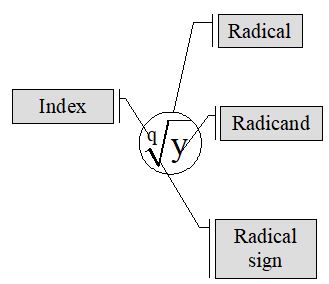12.1 INTRODUCTION
Exponent
If a certain number a is multiplied m times in succession, then the continued product so obtained is called the power of a and is written as (read as, a to the power m).
Thus, = a × a × a × a…….. to m factors.
Here, a is called the base of and m is called the index or exponent of .
Examples
i)
ii) (–3)6 = (–3)(–3)(–3)(–3)(–3)(–3)
Note
In particular, a2 is called the square of a (or, ) and a3 is called the cube of a (or )
Root
If a and x are two real numbers and n is a positive integer such that an = x, then a is called the root of x and is written as
Clearly, root of x (i.e., ) is such a number whose power is equal to x i.e., .
i) In particular, if , then a is called the second root or square root of x and is written as
ii) If a3 = x, then a is called the third root or cube root of x and is written as
Examples
i) Square Root of 25 is 5 i.e.,
ii) Cube Root of 27 is 3 i.e., 3
iii) Sixth Root of 64 is 2 i.e., 6
Example
Since
Again,
Therefore, it is evident that both 5 and (–5) are square roots of 25.
Hence, by the Square root of a real positive number x we mean
Note
i) If x > 0 and n is any positive integer, then is positive.
ii) If x < 0 and n is any odd integer, then is negative.
iii) If x < 0 and n is any positive even integer, then does not exist in the set of real numbers.
12.2. LAWS OF EXPONENTS
I) Multiplication property :
(Fundamental Index Law)
For multiplying the power of same base, powers are added.
Proof :
Examples :
II) Division property property :
For dividing the powers of same base, we subtract the indices.
Proof :
Case – 1 : If
Example :
Case –2 : If
Example :
III) Power of a power property :
Proof :
Examples
i)
ii)
IV) Power of a product property :
Proof :
Example :
V) Power of a divison property :
Proof :
all the above laws are defind for only.
12.3. NUMBERS WITH NON-INTEGER EXPONENTS
Numbers with non-integer exponents
What if m is not a positive integer ?
If m is not a positive integer, then there exist four cases.
Case-1 : either m = 0
Meaning of a° (a 0)
We know the Fundamental Index law being true for all indices hence,
Now Dividing both sides by we get,
Note : a° has no meaning when a = 0 i.e., 0° has no meaning.
Case-2 : Either where p and q are positive integers.
Meaning of , where p and q are positive integer
Since q is a positive integer, hence,
Thus, is the root of .
Case-3 : Either m is a negative number
Meaning of , where m is a positive real number and
Since the fundamental index law is true for all indices, hence,
Thus is the reciprocal of .
Case-4 : Either where, p and q are positive integers.
We have,
Equations and identities involving Indices
If a, m, n are three real numbers and
Proof : Since
12.4. RATIONAL EXPONENT
I) Rational Number
The fraction where p and q are integers, is called a rational number.
II) Positive Rational Exponent
Let a be a positive real number and n a positve fraction equal to where p and q are positive integers, the equation has one and only positive solution for x, given by .
III) Negative Rational Exponent
If n is a negative rational, i.e. , where and a is a positive real number, then
Consider,
IV) Also, all the laws of indices applicable for integral index are also applicable for rational index.
i.e., if a is a positive real number and m, n are rational numbers, then,
i)
ii)
iii)
12.5. RADICAL AND RADICAND
We know that if then we can write it as
Here, y is called ‘Radical form’ of

i) In is called Radical Sign
ii) is called a Radical
iii) q is called Index of the radical
iv) y is called the Radicand
Note : Index of a radical is always positive
Important Results
i)
ii)
iii)
iv)
v)








